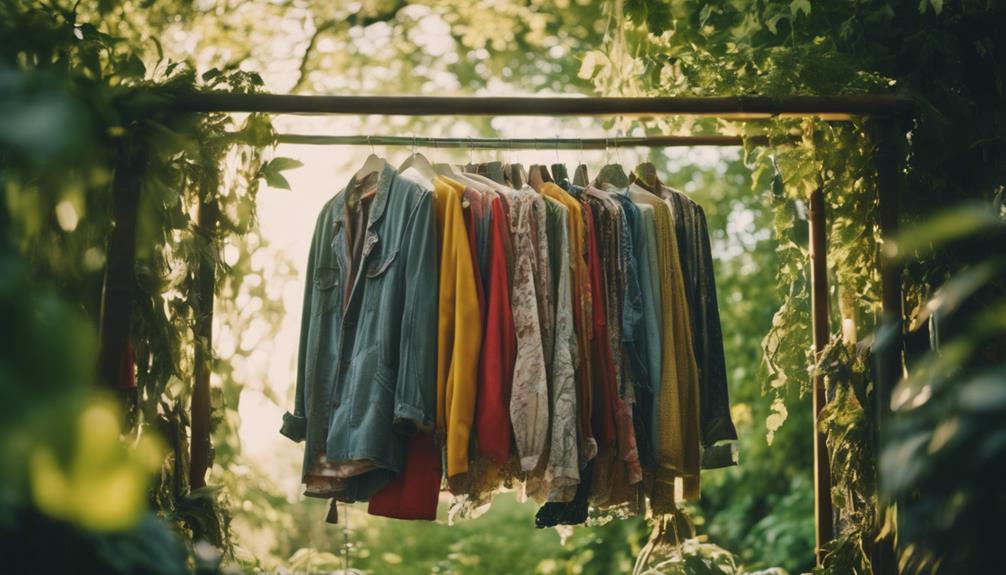Yes, vintage fashion is a sustainable choice. By choosing vintage, you decrease the need for new clothing production, which helps reduce your environmental impact. Vintage pieces are often crafted from top-quality materials, ensuring they are durable and long-lasting. This not only encourages a culture of reuse but also supports ethical practices by reducing dependence on fast fashion. While there are some concerns about transparency and sourcing, the overall advantages of selecting vintage fashion make it a conscientious choice. Interested in learning more about the sustainability of vintage clothing? There is plenty more to discover on this subject!
Key Takeaways
- Vintage fashion reduces the demand for new clothing production, conserving resources and minimizing environmental impact.
- High-quality materials and craftsmanship in vintage garments promote durability, contributing to long-term waste reduction.
- Choosing vintage supports ethical sourcing practices and local economies, fostering community growth and responsible consumerism.
- Vintage shopping encourages a circular economy by promoting reuse and reducing landfill accumulation of textiles.
Understanding Vintage Fashion
Vintage fashion includes garments that are 20 to 100 years old, showcasing the unique styles and trends of different decades.
As you explore vintage clothing, you'll notice how it reflects the evolution of fashion and societal norms. This appreciation for vintage has shifted from a mere trend to a status symbol, primarily due to the growing demand for sustainable clothing alternatives to fast fashion.
When you choose vintage pieces, you're not just opting for unique styles; you're also making a conscious choice for sustainability. Each vintage garment reduces the need for new production, which in turn lessens the environmental impact of garment manufacturing.
Unlike fast fashion items, vintage clothing is often made with superior quality materials, ensuring durability and longevity. This quality means you're more likely to wear these garments for years, further reducing waste.
Embracing vintage fashion allows you to disrupt the fast fashion cycle. By investing in pre-loved pieces, you contribute to a culture of reuse and repurposing, promoting a more ethical approach to fashion.
Environmental Benefits of Vintage
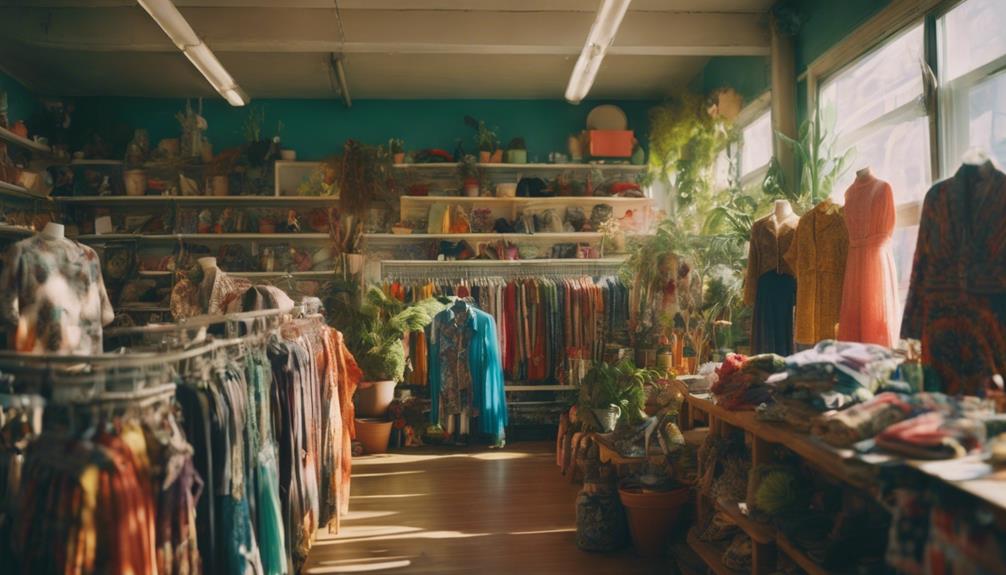
When you choose vintage fashion, you help cut down the need for new clothing production, which saves essential resources like water and energy.
These timeless pieces not only showcase superior craftsmanship but also last longer, reducing waste in the long run.
Reducing New Production Needs
Choosing vintage fashion cuts down on the need for new clothing production, which saves precious resources like water and energy. By opting for vintage clothing, you're actively participating in sustainable fashion. Each time you purchase a vintage piece, you help bypass the most polluting stage of the supply chain, greatly reducing the overall environmental impact of the fashion industry.
Reducing new production needs is essential, especially when you consider that the fashion industry generates a staggering 92 million tons of solid waste annually. Vintage items contribute to waste reduction by promoting reuse and repurposing, allowing you to enjoy unique styles while minimizing your ecological footprint.
Furthermore, vintage garments are often crafted with care and attention to detail, ensuring durability that outlasts fast fashion trends. This longevity means fewer new items need to be produced, creating a positive cycle of sustainability.
When you choose vintage, you also send a powerful message to the industry about the demand for ethical manufacturing practices. Your choices can influence future production methods, encouraging brands to prioritize sustainability and reduce their environmental impact.
Longevity and Craftsmanship Benefits
Craftsmanship and durability in vintage fashion stand out as major advantages, as these garments are often built to last far longer than their fast fashion counterparts. When you choose vintage, you're embracing longevity.
These pieces not only showcase superior craftsmanship but are crafted from high-quality materials that withstand the test of time. This durability translates to fewer purchases over your lifetime, making your wardrobe more sustainable.
Every vintage item you opt for reduces the demand for new garment production, directly lessening the environmental strain tied to resource extraction and manufacturing processes. By bypassing the most polluting stages of the supply chain, you're minimizing waste and emissions. You're also contributing to a culture that values timeless fashion rather than disposable trends.
Moreover, vintage clothing fosters a circular economy, as it encourages the reuse of unique garments instead of allowing them to pile up in landfills. This choice not only supports waste reduction but also celebrates the artistry of fashion through craftsmanship.
Ethical Considerations in Vintage
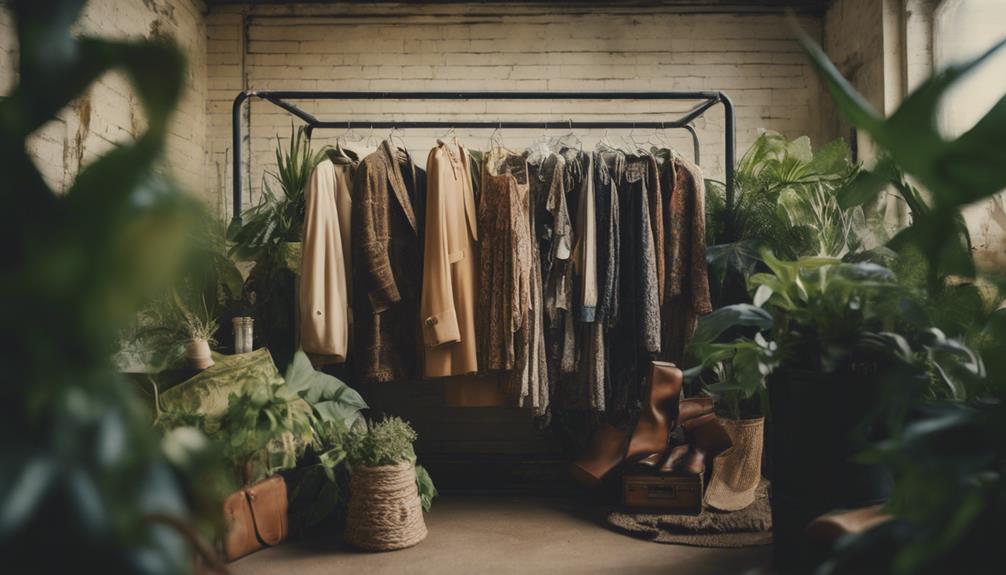
When you choose vintage fashion, you're not just making a style statement; you're also making a choice about ethics.
It's important to take into account ethical sourcing practices, worker rights, and the transparency of supply chains in the vintage market.
Ethical Sourcing Practices
Ethical sourcing in vintage fashion considerably reduces the demand for new production, making it a conscious choice for eco-minded consumers. By choosing pre-owned garments, you actively participate in ethical fashion, minimizing environmental impact and promoting sustainability. Many vintage shops prioritize transparency, curating collections that support fair labor practices and align with the values of responsible shoppers.
When you opt for vintage, you're not just getting unique pieces; you're also repurposing high-quality materials often produced before harmful chemicals became standard. This choice contributes to a more sustainable wardrobe while also benefiting local economies. Supporting vintage shops means you're promoting small businesses and artisans who specialize in curating and reselling these pre-loved items, fostering community growth.
As you navigate the vintage market, remember that not all pieces have the same origins. You can assess the ethical implications of your purchases by seeking shops that prioritize responsible sourcing and transparency in their supply chains. By doing so, you align your fashion choices with sustainable brands that genuinely care about the impact they've on people and the planet.
Worker Rights and Conditions
Vintage fashion often champions worker rights by encouraging responsible purchasing habits that can uplift marginalized communities and promote fair labor practices. By choosing vintage items, you help reduce the demand for new garment production, which often exploits workers in fast fashion industries. This shift in purchasing behavior not only diverts funds from large corporations that pay below livable wages but also supports local economies and artisans who benefit from fair wages and better working conditions.
However, it's crucial to recognize that the vintage market isn't without its challenges. Some vintage shops may lack transparency, making it difficult to ascertain their commitment to ethical sourcing and worker rights. As a consumer, you have the power to advocate for businesses that prioritize ethical practices. By supporting shops that emphasize fair labor conditions and ethical sourcing, you contribute to a more sustainable fashion landscape.
In this way, vintage fashion can offer a viable alternative to traditional retail, fostering a culture of responsibility and ethics. Your choices matter, and they can lead to positive changes for workers in the fashion industry.
Transparency in Supply Chains
Transparency in supply chains is essential for ensuring that the vintage fashion you choose aligns with your values and supports responsible practices.
When you shop for vintage clothing, it's important to understand where those pieces come from and how they were made. Here are a few key points to take into account:
- Many thrift stores and vintage shops lack clear information about their sourcing and production processes.
- Ethical sourcing is critical to avoid items made with toxic materials or from exploitative labor conditions.
Drawbacks of Vintage Clothing
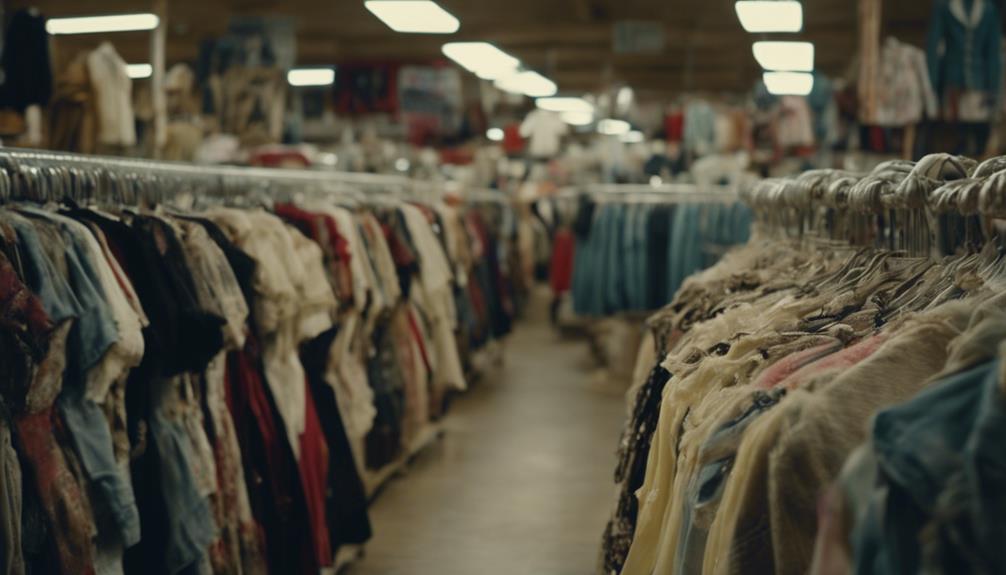
How can you be confident that the vintage clothing you buy is genuinely sustainable when some shops blur the line with new garments designed to mimic retro styles? This can lead to confusion, making it hard to find true vintage finds that actually reduce your environmental impact. Here are some drawbacks to take into account:
| Drawback | Explanation |
|---|---|
| Lack of Transparency | Thrift stores often don't disclose their supply chains, leaving you in the dark about ethical implications. |
| Toxic Materials | Identifying vintage garments made with toxic chemicals can be tricky, risking exposure to harmful substances. |
| Increased Carbon Footprint | Major retailers sourcing vintage items might inadvertently raise their carbon footprint due to logistics. |
| Microplastics from Synthetics | Vintage garments made from synthetic materials can shed microplastics during washing, polluting the environment despite being second-hand clothing. |
While vintage pieces can be stylish and unique, it is crucial to assess these drawbacks to guarantee your choices align with sustainable fashion principles.
Assessing Vintage Sustainability
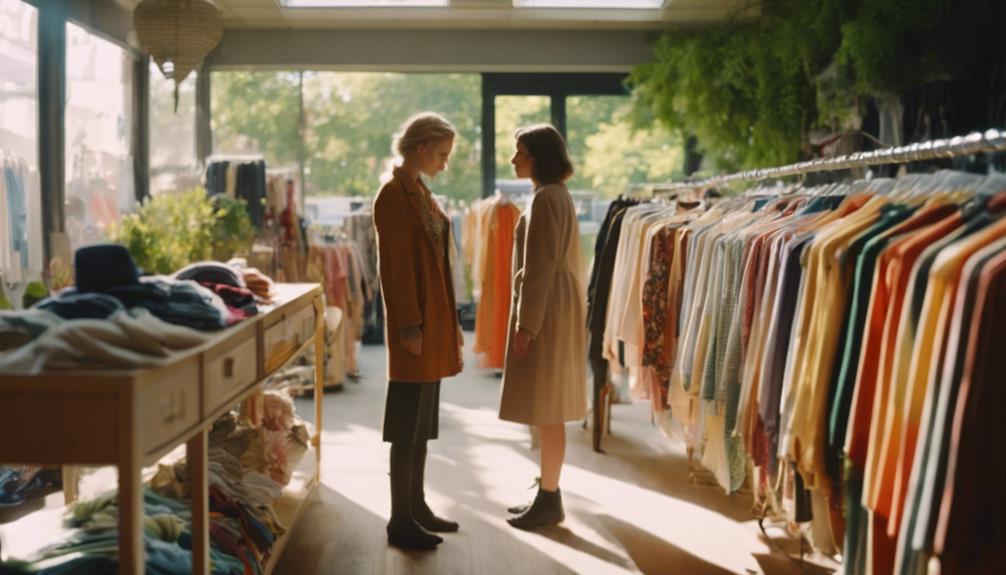
Understanding the sustainability of vintage clothing requires a careful evaluation of its environmental impact and the practices of the shops where you buy. By choosing vintage, you can play a role in reducing textile waste and promoting sustainable fashion.
Here are a few key points to take into account:
- Reduces demand for new production: Vintage clothing helps lessen the environmental strain caused by excessive resource consumption.
- Bypasses polluting stages: When you purchase vintage, you're reusing garments instead of contributing to new manufacturing, which is often more polluting.
However, not all vintage clothing is created equal. Responsible purchasing is essential; you should evaluate the materials and conditions of the items you choose.
The vintage fashion industry also needs to improve transparency in sourcing and environmental practices to guarantee that your choices lead to genuinely sustainable outcomes.
The Vintage Market Experience

Stepping into the vintage market feels like starting a treasure hunt, where every corner holds the potential for unique finds that tell a story. You'll find yourself exploring vintage stores, each packed with garments that span decades, offering styles you won't see in fast fashion. The tactile experience of rummaging through thrift stores, feeling the fabric, and discovering hidden gems adds excitement to your shopping journey.
What makes this experience even more appealing is that it supports sustainable fashion. By opting for vintage, you're not just shopping; you're making a conscious choice to repurpose clothing rather than contributing to the overproduction of new garments. This movement encourages a more ethical approach to fashion consumption, fostering a sense of community and connection to the past.
With online platforms like thredUP and eBay, you can also search for specific styles, making vintage accessible from the comfort of your home. However, nothing beats the thrill of finding that perfect piece in a local vintage store or flea market. Embrace the adventure, knowing that your choices contribute positively to both your wardrobe and the planet.
Personal Expression Through Vintage

Discovering vintage pieces not only enhances your wardrobe but also empowers you to express your unique style in a way that mass-produced fashion simply can't match. When you choose vintage, you're not just picking clothes; you're making a statement about personal expression and sustainability.
Here are a few ways vintage fashion allows you to showcase your individuality:
- Uniqueness: Vintage items reduce the likelihood of outfit duplication, ensuring your style stands out.
- Eclectic Mix: You can blend pieces from various decades, creating a wardrobe that truly reflects your personality.
Cultural Shift Towards Vintage Fashion
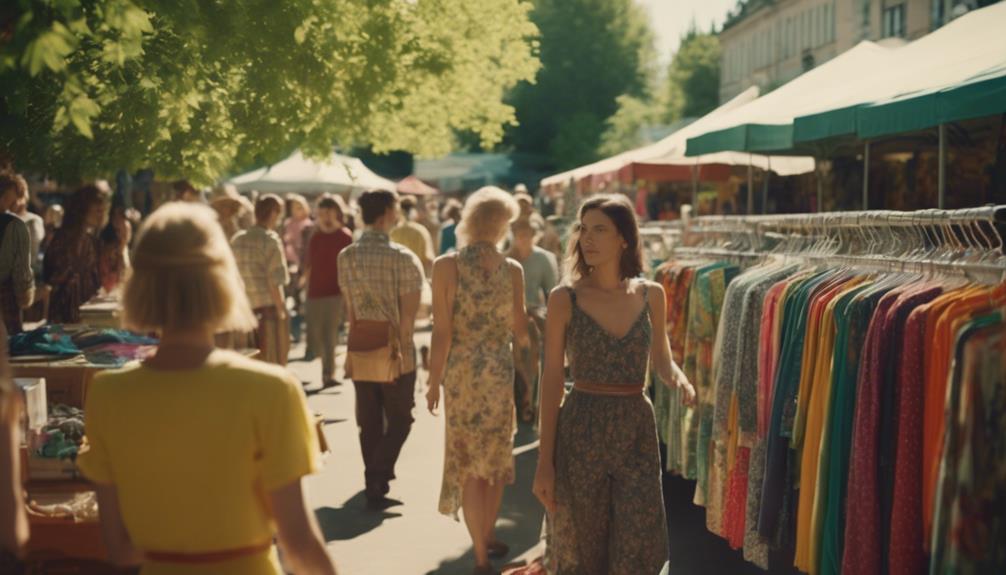
Embracing vintage fashion reflects a significant cultural shift as consumers increasingly prioritize sustainability and individuality over the fleeting trends of fast fashion.
You're likely noticing how vintage fashion has become a beacon of sustainable practices in a world often marred by wastefulness. By choosing vintage, you're not just opting for unique pieces; you're actively participating in conscious consumerism that promotes reusing and repurposing garments.
This movement encourages you to connect with history and craftsmanship, appreciating that each piece carries its own narrative beyond mere aesthetics. As you explore vintage shops, you'll find that these distinctive items allow you to express your individuality, setting you apart from the sea of mass-produced clothing.
Moreover, the rise of vintage fashion signals a broader cultural shift towards valuing sustainability and responsible consumption. By embracing this lifestyle, you're making a statement against disposable culture and contributing to a healthier planet. In addition, the shocking reasons behind sustainable fashion, such as the harmful effects of fast fashion on the environment and the exploitation of garment workers, highlight the importance of choosing vintage and ethically-made clothing. By supporting sustainable fashion, you are advocating for fair labor practices and reducing the demand for environmentally damaging mass production. Ultimately, embracing vintage fashion is not just a style choice, but a powerful statement about your values and commitment to a more conscious and responsible way of living.
It's about more than just looking good; it's about making choices that reflect your values. So, as you step into the world of vintage, remember that your choices matter, and your style can help shape a more sustainable future.
Frequently Asked Questions
Do People Really Care About Sustainable Fashion?
Yes, people really care about sustainable fashion. You're likely noticing how consumers increasingly prioritize eco-friendly brands, with many willing to pay more. Social media and influencers are amplifying this shift towards conscious choices in fashion.
Is Buying Vintage Clothing Sustainable?
Buying vintage clothing is sustainable—each piece you purchase can save around 1,000 gallons of water compared to new garments. By choosing vintage, you're reducing waste and supporting a more eco-friendly fashion industry.
Does Sustainable Fashion Really Work?
Sustainable fashion really works when you actively choose eco-friendly brands and durable materials. By supporting ethical practices and caring for your clothes, you help reduce waste, promote local economies, and encourage a more responsible industry.
What Is the Paradox of Sustainable Fashion?
Imagine a gardener nurturing a vibrant garden while unknowingly choking the roots. The paradox of sustainable fashion lies in balancing eco-friendly ideals with the reality that increased demand can suffocate genuine sustainability efforts and accessibility.
Conclusion
To sum up, vintage fashion isn't just a style choice; it's a sustainable alternative that reduces waste and promotes ethical consumption.
Did you know that buying vintage can save up to 80% of the carbon emissions compared to purchasing new clothing?
By choosing vintage, you're not only expressing your unique personality but also contributing to a more sustainable future.
So, next time you shop, consider diving into the vintage market—you'll be making a stylish and eco-friendly statement!
